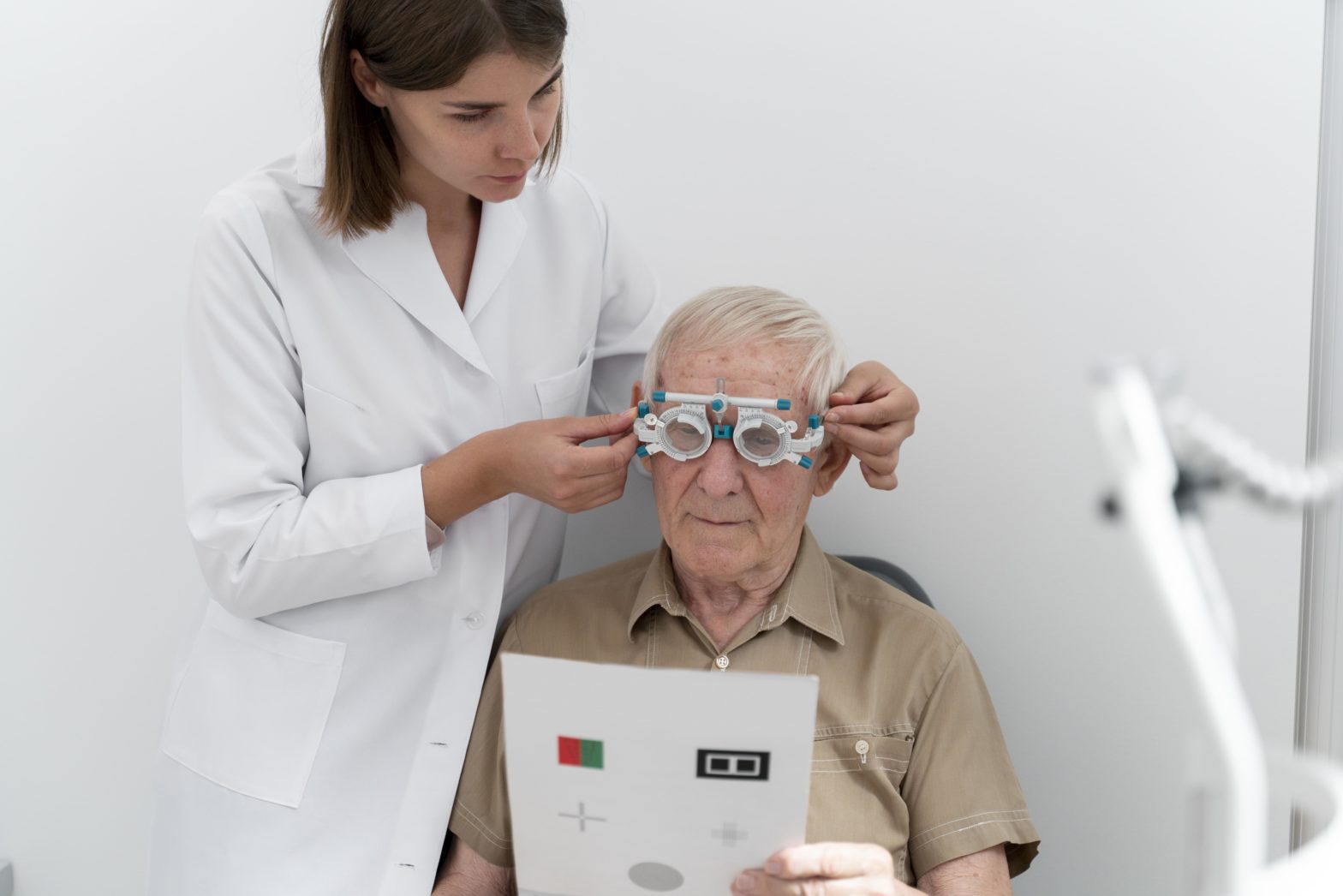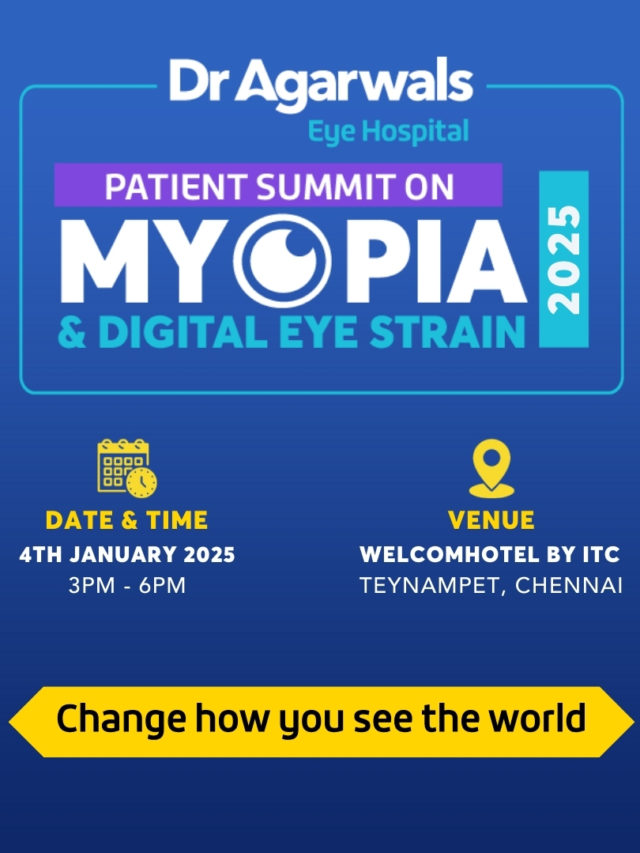આબોહવા પરિવર્તન હવે દૂરનો ખતરો નથી; તે એક તાત્કાલિક વાસ્તવિકતા છે જેની માનવ સ્વાસ્થ્યના વિવિધ પાસાઓ પર, જેમાં આપણી આંખોનો પણ સમાવેશ થાય છે, મૂર્ત અસરો છે. જ્યારે મોટાભાગના લોકો આબોહવા પરિવર્તનને વધતા તાપમાન, આત્યંતિક હવામાન અને કુદરતી આફતો સાથે જોડે છે, ત્યારે આંખના સ્વાસ્થ્ય પર તેની સૂક્ષ્મ છતાં ઊંડી અસરો ઘણીવાર ધ્યાન બહાર રહેતી નથી. જેમ જેમ ગ્રહ ગરમ થાય છે અને પર્યાવરણમાં નાટકીય ફેરફારો થાય છે, તેમ તેમ આંખના સ્વાસ્થ્ય માટે નવા પડકારો ઉભરી રહ્યા છે - યુવી કિરણોના સંપર્કમાં વધારો અને પ્રદૂષણથી લઈને ચેપી રોગોના ફેલાવા સુધી. આ બ્લોગમાં, આપણે શોધીશું કે આબોહવા પરિવર્તન આંખના સ્વાસ્થ્યના લેન્ડસ્કેપને કેવી રીતે ફરીથી આકાર આપી રહ્યું છે અને આ બદલાતી દુનિયામાં આપણી દ્રષ્ટિને સુરક્ષિત રાખવા માટે આપણે શું કરી શકીએ છીએ.
આબોહવા પરિવર્તન અને આંખના સ્વાસ્થ્ય વચ્ચેનું જોડાણ
૧. યુવી કિરણોત્સર્ગના સંપર્કમાં વધારો
આબોહવા પરિવર્તનની સૌથી તાત્કાલિક અને દૃશ્યમાન અસરોમાંની એક ઓઝોન સ્તરનું અવક્ષય છે, જે હાનિકારક અલ્ટ્રાવાયોલેટ (યુવી) કિરણો સામે પૃથ્વીના કુદરતી કવચ તરીકે કાર્ય કરે છે. જેમ જેમ આ રક્ષણાત્મક અવરોધ નબળો પડે છે, તેમ તેમ વધુ યુવી કિરણો સપાટી પર પહોંચે છે, જેનાથી આંખની વિવિધ સ્થિતિઓનું જોખમ વધે છે જેમ કે:
- ફોટોકેરાટાઇટિસ (આંખમાં સૂર્યપ્રકાશ): યુવી કિરણોત્સર્ગના લાંબા સમય સુધી સંપર્કમાં રહેવાથી આ પીડાદાયક સ્થિતિ થઈ શકે છે, જેના કારણે દ્રષ્ટિનું કામચલાઉ નુકસાન થઈ શકે છે.
- મોતિયા: યુવી કિરણોત્સર્ગ વિકાસને વેગ આપે છે મોતિયા, વિશ્વભરમાં અંધત્વના મુખ્ય કારણોમાંનું એક.
- મેક્યુલર ડિજનરેશન: લાંબા સમય સુધી યુવી કિરણોના સંપર્કમાં આવવાથી રેટિનાને નુકસાન થઈ શકે છે, જે વય-સંબંધિત મેક્યુલર ડિજનરેશન (AMD) માં ફાળો આપે છે.
યુવી-રક્ષણાત્મક સનગ્લાસ અને પહોળી કાંટાવાળી ટોપી પહેરવાથી આ જોખમો નોંધપાત્ર રીતે ઘટાડી શકાય છે.
2. વાયુ પ્રદૂષણ અને સૂકી આંખ સિન્ડ્રોમ
જેમ જેમ વૈશ્વિક તાપમાનમાં વધારો થાય છે, તેમ તેમ વાયુ પ્રદૂષણની ઘટનાઓની આવર્તન અને તીવ્રતા પણ વધી રહી છે. કણો (PM), નાઇટ્રોજન ડાયોક્સાઇડ (NO₂), અને સલ્ફર ડાયોક્સાઇડ (SO₂) જેવા પ્રદૂષકો આંખોમાં બળતરા પેદા કરી શકે છે અને નીચેની પરિસ્થિતિઓને વધારી શકે છે:
- ડ્રાય આઇ સિન્ડ્રોમ: વાયુજન્ય પ્રદૂષકો આંસુના પડદાને વિક્ષેપિત કરી શકે છે, જેના કારણે શુષ્કતા, બળતરા અને અસ્વસ્થતા થાય છે.
- એલર્જીક નેત્રસ્તર દાહ: એલર્જન અને પ્રદૂષકોના સંપર્કમાં આવવાથી આંખોમાં બળતરા અને લાલાશ થાય છે.
શહેરી વિસ્તારો અથવા જંગલની આગની સંભાવના ધરાવતા વિસ્તારોમાં રહેતા લોકો ખાસ કરીને જોખમમાં છે. આ અસરોને ઘટાડવા માટે, કૃત્રિમ આંસુ, હવા શુદ્ધિકરણ અને રક્ષણાત્મક ચશ્માનો ઉપયોગ કરવાની ભલામણ કરવામાં આવે છે.
૩. તાપમાનમાં વધારો અને આંખના ચેપનો ફેલાવો
ઉચ્ચ તાપમાન અને ભેજનું સ્તર બેક્ટેરિયા, વાયરસ અને ફૂગના પ્રજનન માટે આદર્શ પરિસ્થિતિઓ બનાવે છે જે આંખના ચેપનું કારણ બની શકે છે. આબોહવા પરિવર્તન રોગ વહન કરતા જંતુઓના વિતરણમાં પણ ફેરફાર કરી રહ્યું છે, જેના કારણે ચેપનો ફેલાવો થાય છે જેમ કે:
- ટ્રેકોમા: એક બેક્ટેરિયલ ચેપ જેની સારવાર ન કરવામાં આવે તો તે અંધત્વનું કારણ બની શકે છે, જે સ્વચ્છતા નબળી હોય તેવા વિસ્તારોમાં વધુ સામાન્ય છે.
- એકેન્થામોએબા કેરાટાઇટિસ: દૂષિત પાણી સાથે જોડાયેલ ગંભીર કોર્નિયલ ચેપ, ખાસ કરીને કોન્ટેક્ટ લેન્સ પહેરનારાઓને અસર કરે છે.
આવા ચેપને રોકવા માટે સ્વચ્છતામાં સુધારો કરવો, સારી સ્વચ્છતા જાળવવી અને દૂષિત પાણીના સંપર્કમાં આવવાનું ટાળવું એ જરૂરી પગલાં છે.
4. જંગલની આગનો ધુમાડો અને આંખોમાં બળતરા
વાતાવરણમાં પરિવર્તનને કારણે જંગલમાં લાગેલી આગની આવર્તન અને તીવ્રતામાં વધારો થયો છે, જેના કારણે હવામાં મોટા પ્રમાણમાં ધુમાડો અને સૂક્ષ્મ કણો છૂટા પડી રહ્યા છે. આ કણો તાત્કાલિક અને લાંબા ગાળાની આંખની સમસ્યાઓનું કારણ બની શકે છે, જેમાં નીચેનાનો સમાવેશ થાય છે:
- બળતરા અને લાલાશ: ધુમાડાના કણો આંખોમાં બળતરા કરે છે, જેનાથી અસ્વસ્થતા અને આંખો ફાટી જાય છે.
- લાંબા ગાળાનું નુકસાન: ધુમાડાના લાંબા સમય સુધી સંપર્કમાં રહેવાથી આંખના ક્રોનિક રોગો થઈ શકે છે.
જંગલમાં આગ લાગવાની ઘટનાઓ દરમિયાન, રક્ષણાત્મક ચશ્મા પહેરવા, ઘરની અંદર રહેવા અને એર ફિલ્ટરનો ઉપયોગ કરવાથી તમારી આંખોનું રક્ષણ કરવામાં મદદ મળી શકે છે.
૫. ઋતુ પરિવર્તન અને એલર્જી
આબોહવા પરિવર્તનને કારણે પરાગ ઋતુઓ લાંબી અને વધુ તીવ્ર બની છે, જેના કારણે ઘણી વ્યક્તિઓમાં એલર્જીક પ્રતિક્રિયાઓ વધી છે. આંખની એલર્જીથી પીડાતા લોકો માટે, આનો અર્થ એ છે કે લક્ષણોનું જોખમ વધારે છે જેમ કે:
- આંખોમાં ખંજવાળ અને પાણી આવવું
- પોપચાંની સોજો
- ઝાંખી દ્રષ્ટિ
આ લક્ષણોનું સંચાલન કરવા માટે નિવારક પગલાં લેવાની જરૂર છે જેમ કે ઉચ્ચ પરાગ રજના દિવસોમાં બહારના સંપર્કને મર્યાદિત કરવો અને એન્ટિહિસ્ટેમાઈન આંખના ટીપાંનો ઉપયોગ કરવો.
૬. પીગળતા બરફના ટોપા અને યુવી પ્રતિબિંબ
જેમ જેમ હિમનદીઓ અને બરફના ઢોળાવ પીગળે છે, તેમ તેમ વાતાવરણમાં યુવી કિરણોને ઉછાળતો પ્રતિબિંબિત સપાટી વિસ્તાર વધે છે. આ ઘટના ખાસ કરીને ધ્રુવીય પ્રદેશો અથવા ઉચ્ચ ઊંચાઈવાળા લોકો માટે ખતરનાક છે, જ્યાં તીવ્ર યુવી પ્રતિબિંબનું કારણ બની શકે છે:
- બરફ અંધત્વ: બરફ અને બરફમાંથી યુવી પ્રતિબિંબના પરિણામે ફોટોકેરાટાઇટિસનું ગંભીર સ્વરૂપ.
આ વિસ્તારોના પ્રવાસીઓ અને રહેવાસીઓએ નુકસાન ટાળવા માટે ખાસ યુવી-રક્ષણાત્મક ગોગલ્સ પહેરવા જોઈએ.
સંવેદનશીલ વસ્તી: કોને વધુ જોખમ છે?
અમુક જૂથો આંખના સ્વાસ્થ્ય પર આબોહવા પરિવર્તનની પ્રતિકૂળ અસરો માટે વધુ સંવેદનશીલ હોય છે:
- બાળકો અને વૃદ્ધો: તેમની આંખો યુવી કિરણોત્સર્ગ અને પ્રદૂષણ પ્રત્યે વધુ સંવેદનશીલ હોય છે.
- બહાર કામ કરતા કામદારો: ખેડૂતો, બાંધકામ કામદારો અને અન્ય લોકો જે લાંબા સમય સુધી બહાર વિતાવે છે તેઓ પર્યાવરણીય જોખમોના વધુ પડતા સંપર્કમાં આવે છે.
- કોન્ટેક્ટ લેન્સ પહેરનારાઓ: પ્રદૂષણ અને પાણીની નબળી ગુણવત્તાને કારણે તેમને આંખના ચેપનું જોખમ વધુ હોય છે.
આપણી આંખોનું રક્ષણ કરવા શું કરી શકાય?
જ્યારે આબોહવા પરિવર્તન એક વૈશ્વિક મુદ્દો છે, ત્યારે આપણે આપણી આંખના સ્વાસ્થ્યને સુરક્ષિત રાખવા માટે વ્યક્તિગત અને સમુદાય સ્તરે કેટલાક પગલાં લઈ શકીએ છીએ:
વ્યક્તિગત સુરક્ષા
- સનગ્લાસ પહેરો: 100% યુવી પ્રોટેક્શનવાળા ચશ્મા પસંદ કરો.
- હાઇડ્રેટેડ રહો: યોગ્ય હાઇડ્રેશન આંસુની સપાટીને સ્વસ્થ રાખવામાં મદદ કરે છે.
- કૃત્રિમ આંસુનો ઉપયોગ કરો: પ્રદૂષણ અને ઘરની અંદર ગરમીને કારણે થતી શુષ્કતા સામે લડવું.
- નિયમિત આંખની પરીક્ષાઓ: સંભવિત સમસ્યાઓને વહેલાસર શોધી કાઢો અને તેનું સંચાલન કરો.
સમુદાય અને નીતિગત પગલાં
- સ્વચ્છ હવા નીતિઓના હિમાયતી: ઉત્સર્જન ઘટાડવાથી વાયુ પ્રદૂષણ સંબંધિત આંખોની સ્થિતિ ઓછી થઈ શકે છે.
- ટકાઉ વિકાસને ટેકો આપો: ટકાઉ પ્રથાઓ દ્વારા આબોહવા પરિવર્તનને ઓછું કરવાથી એકંદર સ્વાસ્થ્યને ફાયદો થશે.
- આંખની સંભાળની પહોંચમાં સુધારો: સંવેદનશીલ વિસ્તારોમાં સસ્તી આંખની સંભાળની સુલભતા સુનિશ્ચિત કરવી ખૂબ જ મહત્વપૂર્ણ છે.
ગરમ થતી દુનિયામાં આંખના સ્વાસ્થ્યનું ભવિષ્ય
જેમ જેમ આબોહવા પરિવર્તનની અસરો તીવ્ર બનશે, તેમ તેમ આંખના સ્વાસ્થ્ય સામે પડકારો પણ વધશે. જોકે, જાગૃતિ અને સક્રિય પગલાં ઘણા જોખમોને ઘટાડવામાં મદદ કરી શકે છે. આબોહવા પરિવર્તન અને આંખના સ્વાસ્થ્ય વચ્ચેની કડીને સમજીને, આપણે ભવિષ્ય માટે વધુ સારી રીતે તૈયારી કરી શકીએ છીએ અને આપણી સૌથી મહત્વપૂર્ણ ઇન્દ્રિયોમાંથી એકનું રક્ષણ કરી શકીએ છીએ.
ભલે તમે પ્રદૂષણથી ભરેલા શહેરોમાં ટ્રેકિંગ કરી રહ્યા હોવ કે બહારના સાહસોનો આનંદ માણી રહ્યા હોવ, બદલાતા વાતાવરણમાં તમારા દ્રષ્ટિકોણનું રક્ષણ કરવું એ માત્ર એક સાવચેતી નથી - તે એક આવશ્યકતા છે.
આબોહવા પરિવર્તનની અસરો દૃશ્યમાન પર્યાવરણીય પરિવર્તનોથી ઘણી આગળ વધે છે. યુવી કિરણોત્સર્ગ અને વાયુ પ્રદૂષણમાં વધારો થવાથી લઈને ચેપી રોગોના ફેલાવા સુધી, આંખના સ્વાસ્થ્ય માટેના જોખમો વાસ્તવિક છે અને વધી રહ્યા છે. નિવારક પગલાં અપનાવીને, સ્વચ્છ હવા નીતિઓને પ્રોત્સાહન આપીને અને જાગૃતિ વધારીને, આપણે આપણી આંખોનું રક્ષણ કરી શકીએ છીએ અને ખાતરી કરી શકીએ છીએ કે તે આવનારા વર્ષો સુધી સ્વસ્થ રહે.









